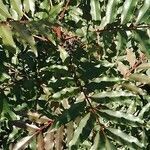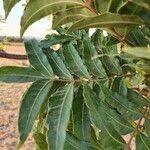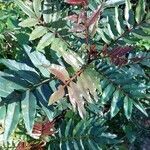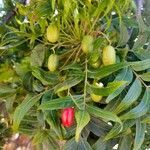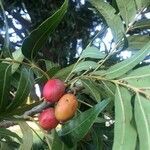A small evergreen tree. It grows 6-15 m tall. It has a round compact crown. The trunk is usually clean and straight. It forests the trunk has buttresses. The bark is silvery white with crossways ridges. The leaves are up to 30 cm long. They are dark green and shiny. New leaves are red. The leaf stalk is 2.5-5 cm long and has a furrow along it. The leaves are crowded towards the ends of branches. The leaves are made up of 4-8 pairs of leaflets. They do not have stalks and there is a leaflet at the end. The leaves are 5-10 cm long and 1.3-2.5 cm wide. The end leaflet is broader and narrowed to the base while the side leaflets are slender and slightly curved. The leaves are leathery. Individual leaves turn red before they fall. Trees are separately male and female. The flowers are small and white. They occur at the ends of branches. The fruit is small with thin skin and sweet flesh. They are 2.5 cm long and 1.3 cm wide. They are red when ripe. The sour fruit pulp is edible. It has one large seed. It is in a distinctively pitted stone.
Leaves 9–17-foliolate; petiole and rhachis 10·5–30 cm. long, glabrous; petiole 4–10 cm. long, furrowed above, convex below; rhachis narrowly winged; leaflets pale green, 4–10 × 1·3–2·5 cm., opposite, the terminal lanceolate to ovate, acuminate at the apex and symmetrically cuneate at the base, the lateral ones lanceolate-falcate, with a very acute apex, cuneate and abruptly contracted at the petiolule-like base, coriaceous, glabrous; midrib slightly raised above, somewhat prominent beneath, lateral nerves 6–8, arcuate, conspicuous above, nearly invisible beneath.
Tree, 2-15 m high; evergreen, bark dark brown, thick and rough, branchlets nodose due to leaf scars, glabrous. Leaves 9-17-foliate, petiole and rachis glabrous, pale green, coriaceous, opposite; terminal lanceolate to ovate; lateral lanceolate-falcate. Flowers in panicles, shorter than leaves. Male flowers: petals whitish or yellowish, oblong-ovate, margins revolute, disc glabrous; stamens 7-10. Female flowers: perianth similar to male; staminodes conspicuous; ovary rhomboid; 4 or 5 sessile stigmas. Fruit a red drupe, fleshy, oblong-ovate. Seeds compressed.
Evergreen tree, up to 15 m high. Leaves compound; leaflets pale green, 40-100 x 13-25 mm, terminal ones lanceolate to ovate, acuminate at apex, symmetrically cuneate at base, lateral ones lanceolate-falcate, with very acute apex, cuneate and abruptly contracted at base. Drupe red, 25-30 x 12-17 mm. Flowers white or yellow.
Male flowers: calyx-lobes 1 mm. long; petals whitish or yellowish, 3 × 1 mm., oblong-ovate, concave, margin revolute; stamens with filaments 2·5 mm. long and anthers c. 1 mm. long; disk glabrous.
An evergreen tree up to 15 m. tall; stem 45–75 cm. in diam., with dark-brown thick rough bark; branchlets nodose due to the leaf-scars, glabrous.
Panicles shorter than the leaves, with axis and branches glabrous.
Drupe red, 2·5–3 × 1·2–1·7 cm.; stone 2·5 × 1·2 cm., oblong-ovate.
Seed compressed.
